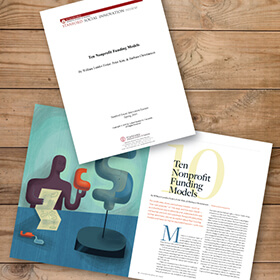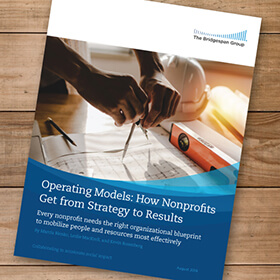Building Stronger Nonprofits, One Idea at a Time
The Bridgespan Group set out 20 years ago to help nonprofits grow stronger and work more effectively. Our commitment to developing practical ways for nonprofits to achieve their missions has remained unchanged even as the social sector has evolved—a reflection of the impact of our research and advocacy.
Initial client demand led us to focus on helping nonprofits develop business plans. Looking back, it's not surprising that business plans commanded Bridgespan's attention in in the early 2000s. Few nonprofits had them. The Edna McConnell Clark Foundation, Bridgespan's inaugural client, was among the first major funders to recognize the vital role of strategic business planning for its grantees. At the time, nonprofits routinely crafted mission and vision statements, but often they were too broad or aspirational to enable clear decision-making regarding programs and resource allocation.
 Business planning caught on as funders and nonprofits saw the value in clarifying strategy and goals to align mission statements and programs. We anchored our business plan discussions in two concepts unique to the nonprofit world: intended impact and theory of change.
Business planning caught on as funders and nonprofits saw the value in clarifying strategy and goals to align mission statements and programs. We anchored our business plan discussions in two concepts unique to the nonprofit world: intended impact and theory of change.
"Intended impact" states clearly what a nonprofit wants to achieve, and for what it will hold itself accountable. It succinctly identifies what results the organization will accomplish, for whom, and in what time frame. A "theory of change" describes how a nonprofit will marshal its staff and financial resources to achieve its intended impact. Together, intended impact and theory of change form a framework for clarifying the goals and strategy that will achieve a nonprofit's mission, as described in "Zeroing in on Impact" in the fall 2004 issue of Stanford Social Innovation Review (SSIR). During Bridgespan's first six years, we collaborated with more than 80 nonprofits to develop business plans. That they soon became the norm validated our work and propelled us to explore a complementary research topic.
Many clients struggled to secure sustainable funding for their ambitious plans. To understand how to take some of the frustration and mystery out of funding, we embarked on a research project that led to the article "Ten Nonprofit Funding Models," which appeared in the spring 2009 issue of SSIR. It became one of the most popular articles in the publication's history.
A funding model is a methodical approach to building a reliable revenue base that will support an organization's core programs and services. While it is common practice among most nonprofits to seek funding from multiple sources, our research showed that 90 percent of the largest nonprofits have embraced funding models built around a single dominant source of revenue (such as a government agency, corporation, or individual donor).
Different types of nonprofits are suited to different funding models, depending on their mission and programs. Nonprofits that have a clear understanding of their funding model, whether based on a dominant source or multiple sources, are able to focus their development efforts on the most promising funding sources and build the staff expertise needed to identify and cultivate those funders.
Effective business planning and successful fundraising address two of the biggest challenges that nonprofits face. But our client work led us to conclude something was missing. Many clients struggled with a disconnect between strategy and on-the-ground implementation, especially during periods of growth. In search of a solution, we adapted a mainstream business concept—the operating model—to guide nonprofits in shaping the high-performance structures and process needed to put strategy into action.
 The operating model concept took root in the business world roughly a decade ago and now figures routinely in companies' strategy-execution discussions. Over the last several years, we have teamed up with Bain & Company to adapt its business-oriented operating model approach to nonprofits. Bain found that companies rated in the top quartile of operating model performance have five-year revenue growth and operating margins significantly higher than for those in the bottom quartile. Nonprofits stand to gain similar benefits in productivity and impact.
The operating model concept took root in the business world roughly a decade ago and now figures routinely in companies' strategy-execution discussions. Over the last several years, we have teamed up with Bain & Company to adapt its business-oriented operating model approach to nonprofits. Bain found that companies rated in the top quartile of operating model performance have five-year revenue growth and operating margins significantly higher than for those in the bottom quartile. Nonprofits stand to gain similar benefits in productivity and impact.
In essence, an operating model defines how a nonprofit works, how it is managed, and how people in the organization interact in service of implementing a strategy. An effective operating model is tailored to support the organization's key decisions and capabilities—those that are necessary for the strategy to succeed. We published "Operating Models: How Nonprofits Get from Strategy to Results" in 2019 to describe how nonprofits can benefit from examining and updating their own operating models.
As Bridgespan marks 20 years of service to nonprofit leaders and their organizations, now is a good time to reflect not just on how far we have come, but on how our work has contributed to change in the social sector. The progression in our advisory work—from business plans to funding models to operating models—shows how we have evolved both to enhance our impact and in response to the impact we have achieved. As the sector grows and evolves, Bridgespan's goal remains unchanged—to help nonprofits make the world a better place.
Created: August 2020
